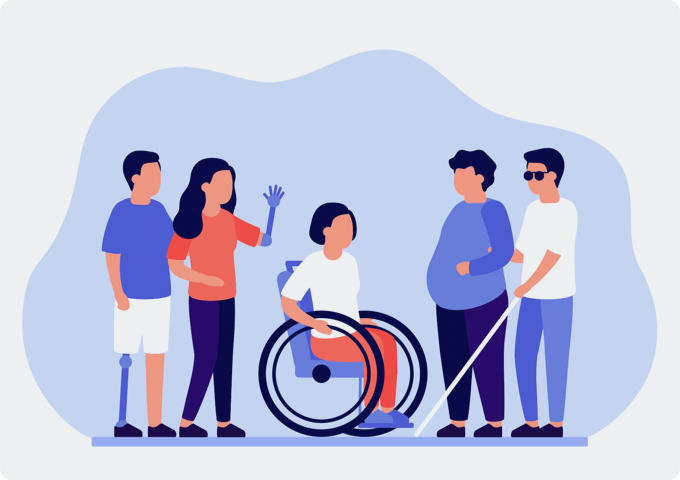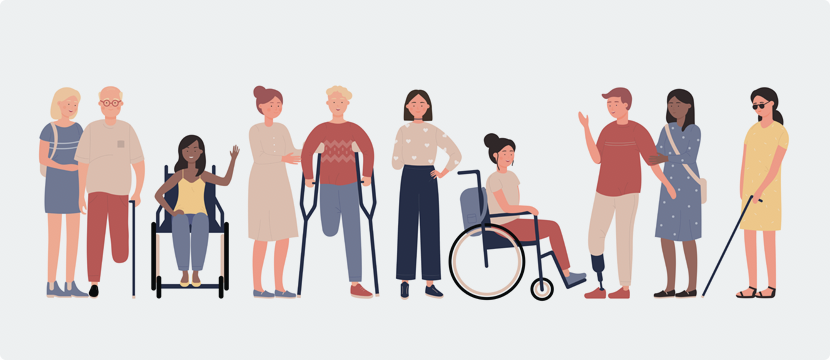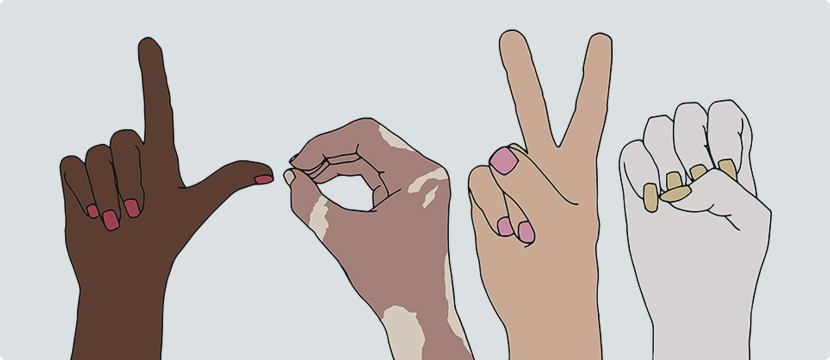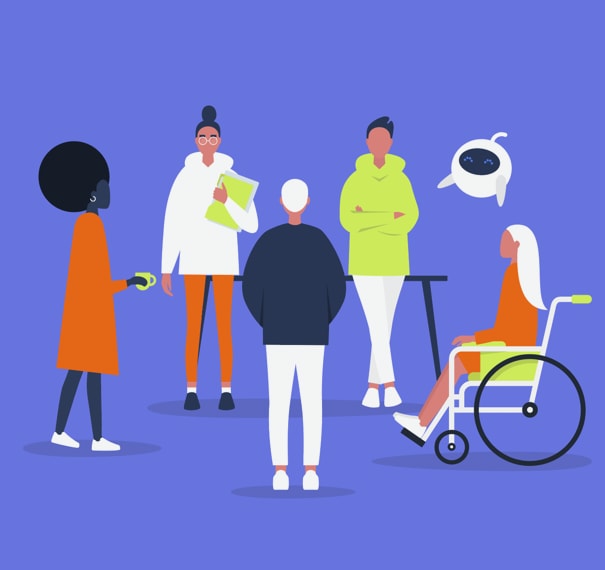

Summary
We often speak of inclusivity in technology as a social good. An act that’s good for conscience and better for the marginalized, but what about the business case? By building products and services with inclusivity at the core, we are not just doing what’s right, but we are also doing what’s right for business. Are social responsibility and commercial success mutually exclusive?
To say technology has transformed every aspect of human life is in some parts an overstatement and others an understatement. While progress through technology has been nothing short of incredible, it also falls staggeringly low on the scale of fairness and equitability. Technology carries the implicit attitudes and values of those that build it. Our most ubiquitous technologies continue to be developed by a small segment of societyⅰ, intensifying exclusion just as much as they promote effectiveness. Frequently, marginalized populations face the brunt of this issue, specifically those with disabilities. A deeper look at the relationship between technology and inclusivity reveals that designing for inclusion is usually an afterthought or a bolt-on, one that’s often padded with messages about ‘doing the right thing’ or ‘making a difference.’ Well-intentioned as these may be, they also carry connotations of condescension and sympathy, which may often be detrimental to genuine inclusivity. Why exactly is this problematic? Read on.
By treating disability as an anomaly, product and service creators treat accessibility as an additional feature, not part of the core value proposition. This approach is riddled with biases and errors in thinking. For any event to be seen as exceptional, it must be rare. Disability is anything but that. In the US alone, over 61 million adults live with a disability. With issues ranging from mobility and vision to self-care and cognition, this segment represents no less than 26% of the adult population in the country.ⅱ The global figures are equally intriguing. According to WHO estimates, close to 15% of the worldwide population, over a billion people, falls under this category, making it the world’s largest minority segment.ⅲ It is no surprise that the Disabled and Elderly Assistive Technology market is estimated to touch US 31.5 billion in the next six years at a CAGR of 6%.ⅳ Assistive technology is but one way to serve these valuable customers.

The Case for Inclusivity
Going by the numbers above, building inclusive technology is not just a tool for social good but also business growth. By leaving out people with disabilities at the product conceptualization and development stage, companies miss out on a tremendous market opportunity of customers eager and willing to be served. Why do companies exclude such a large customer base from their business plans? The problem is one of mindset as much as it is of the method. The conversation needs to move away from a matter of purely social conscience to one of shared growth. Simply put, the industry needs to swap its condescension for collaboration.
Disability at birth is merely one segment of the people living with such challenges. Others could experience disability because of accidents, lifestyle issues, and age. This change has an effect on their needs, but not so much on their preferences, a fact that current design processes find easy to confuse. For instance, in the developed world, the size of the aging demographic and age-related disability is substantial. Their challenges are significant and should feature at the inception of an idea and not as an additional feature. Disability should not be a driver of marginalization but of inclusion and growth. The proliferation of technology should drive products and services designed for people across the ability spectrum. For any technology to be genuinely successful, ubiquitous, it needs widespread adoption, and that scale requires a broadening of the user base. Ignoring an entire demographic does not accomplish that goal. Conversely, building a process, culture, and philosophy with inclusivity at the core could help companies convert the incredible opportunity that lies dormant even today. So, where can they start?

Redefining Processes for Inclusive Outcomes
-
The Importance of Design to Inclusive Technology
The first step for companies is to earn skin in the game and develop more inclusive technology. This journey begins with their design process. Enterprise can modify individual products and services for better accessibility, but real change lies in shifting the design process’s vantage point. The best way to learn is to make. By creating inclusive products designed to service users across the spectrum of abilities, enterprises can gain valuable insights to inform future iterations. Over time, enterprises must endeavor to build inclusivity-first products and services just as they develop mobile-first or desktop-first products. Accessibility must be just as essential and intuitive as any other function.
-
Developing organizations capable of nurturing a wide variety of talent
For enterprises to instill diversity into their design process, they should begin by building diverse teams. Also, it is essential to review the design process and establish where the user blind spots lie, so teams can then engage with people who can offer insights from experience. It is crucial to ‘design with and not just for’ⅴ the people often ignored. A team with diverse underpinnings will also improve the creativity and quality of discourse in the creation process, potentially leading to more innovative, relevant, and scalable products. Further, engaging with diverse perspectives and viewpoints will inevitably lead to more accessible products capable of driving exceptional experiences across the spectrum of users.
-
The features of inclusive technology
Once you decide to shift your design approach, how can you identify that a product or service is inclusive? One way is to check the legislation for your location, such as the Americans with Disabilities Act (ADA) in the US. Frameworks like the Web Content Accessibility Guidelines (WCAG) provide location-agnostic accessibility guidelines for all web design. Compliance is just one part of the accessibility paradigm, and enterprises need to view accessibility-led design as part of a better user experience. It is the definition of users that needs broadening and not just the idea of accessibility. The Infosys Center For Emerging identified this need and developed the Infosys Accessibility Testing Tool (iATT), which uses built-in intelligence to assess websites for accessibility and generate comprehensive web accessibility and visual consistency reports. The tool is now recommended by W3C (World Wide Web Consortium).
Loved what you read?
Get practical thought leadership articles on AI and Automation delivered to your inbox


Loved what you read?
Get practical thought leadership articles on AI and Automation delivered to your inbox
A Shift in Philosophy
Building for inclusivity is a fundamental shift in philosophy. Enterprises are doing themselves a favor by serving a customer base eager to use and pay for high-quality products and services. The relationship is one of mutual growth and benefit. When companies are hard-pressed to grow in a highly competitive and fragmented world, building more usable products is an effective route to scale. We are moving towards a world that celebrates diversity. Businesses must make the changes that help them understand that inclusivity and accessibility are about commerce just as they are about conscience.
References:
- https://www.digitalcommerce360.com/2020/06/23/from-apple-to-facebook-tech-companies-diversity-pledges-have-little-progress/
- https://www.cdc.gov/ncbddd/disabilityandhealth/infographic-disability-impacts-all.html
- https://www.who.int/teams/noncommunicable-diseases/sensory-functions-disability-and-rehabilitation/world-report-on-disability#:~:text=About%2015%25%20of%20the%20world’s,a%20figure%20of%20around%2010%25
- https://www.researchandmarkets.com/reports/5028007/disabled-and-elderly-assistive-technologies
- https://hbr.org/2020/10/to-build-more-inclusive-technology-change-your-design-process





